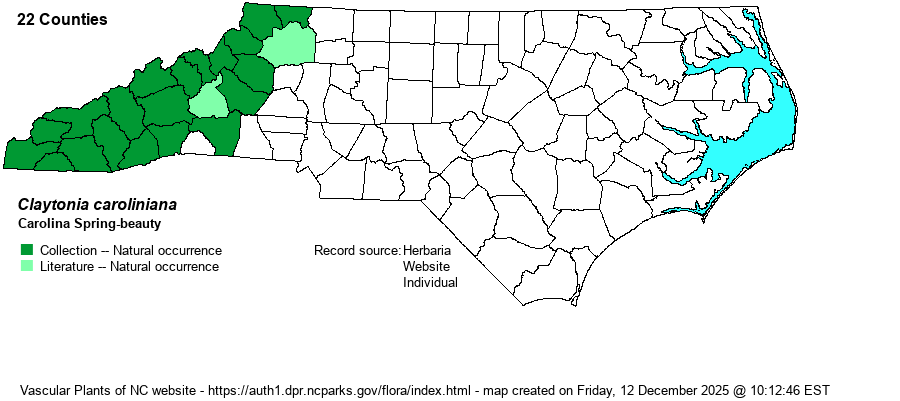| Author | Michaux | |
| Distribution | Throughout the Mountains, but apparently not quite reaching the upper portions of the adjacent Piedmont.
This is a Northern species, ranging from eastern Canada south to New England and MN, but southward mostly in Mountains, to northern GA and northern AL. | |
| Abundance | Frequent to common in the higher Mountains, mostly above 3500 feet, much less numerous at lower elevations, where C. virginica is the common species. | |
| Habitat | This is a characteristic species of Rich Cove Forests, Northern Hardwood Forests, and other rich or moist forests at the higher elevations. |
| Phenology | Blooms in March and April, and fruits shortly after flowering. Plants have withered by May and are no longer visible on the forest floor. | |
| Identification | This is a familiar spring ephemeral wildflower of the state's higher elevations, more so above 4000 feet. It has a single stem, generally erect to leaning, but only about 6-8 inches tall, with only a few stem leaves. These are opposite, lanceolate to elliptic, about 2 inches long and 2/3-inch wide, with a distinct petiole. In this species, the blade is wide enough that the petiole is clearly noticeable; in C. virginica, the leaves are linear and the petiole is essentially not noticeable. Both species have a short raceme at the end of the stem, of 6-20 flowers, only a few in bloom at a time; each has white to light pink petals, with pink veins, that are elliptical and spreading, and the open flower is about 1-inch across, reasonably large for the small size of the plant. In this species, the petals tend to have strong enough pink to red veins such that the petals normally have a pink tint at a distance. Thankfully, both species grow in dense patches, and many a rich forest floor has one of these two species carpeting parts of the ground. | |
| Taxonomic Comments | None
| |
| Other Common Name(s) | None | |
| State Rank | S4 | |
| Global Rank | G5 | |
| State Status | | |
| US Status | | |
| USACE-agcp | FACU link |
| USACE-emp | FACU link |

